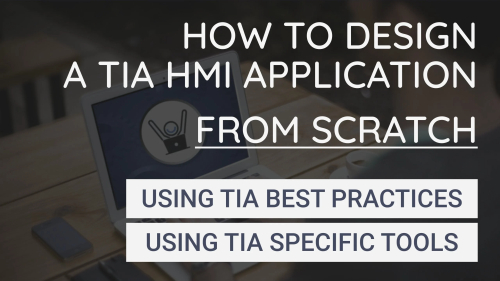Siemens TIA Portal - HMI Basics
Duration: 5h 36m | .MKV 1280x720, 30 fps(r) | AAC, 48000 Hz, 2ch | 3.7 GB
Genre: eLearning | Language: English
Duration: 5h 36m | .MKV 1280x720, 30 fps(r) | AAC, 48000 Hz, 2ch | 3.7 GB
Genre: eLearning | Language: English
Are you excited about building HMI applications in TIA Portal but you're not really sure where to start? After finishing this course, you can confidently add "TIA Portal - HMI Application Builder" to your CV & start getting paid for your new skills.
Hi there! My name is Hans and I'm a full-time controls & automation engineer. I am here to help you learn the basic concepts, tools, and functions that you will need to build modern, fully functional, and intuitive SIMATIC WinCC applications within the widely popular totally integrated automation solution - Siemens TIA Portal. By the end of this course, you will be able to build HMI applications using TIA specific tools and TIA best practices.
Master fundamental skills and concepts in TIA Portal with this Fully Featured HMI Course
Build the layout for your modern and intuitive screen template (using layers and main application colours)
Visualize the process overview of your application using custom animated graphics, text and parameters (graphic lists)
Add alarm handling using alarm texts and an alarmscreen with an alarm view object and reset button
Implement recipe handling to your application (using recipes, data records, and recipe elements)
Configure users and user groups, and add authorizations to screen objects for increased security
Simulate and test your HMI application locally on your laptop without any other hardware required
Essential TIA Tools and Best Practices at Your Fingertips
Learning the fundamentals of designing TIA HMI applications puts a powerful and very useful tool at your fingertips. TIA Portal is one of the leading automation platforms used in industry, offering automation solutions for manufacturing companies all over the world.
Jobs in TIA development are plentiful. Learning the foundation of HMI applications in TIA Portal will give you a running start in the market and a strong background to more easily add advanced concepts to your skillset.
Who did I design this course for:
This course is for anyone interested in starting with Siemens TIA Portal HMI design
This course is especially beneficial to people who already have WinCC and/or HMI knowledge
This course is for software developers who want to reduce their design time by half and upgrade their TIA skillset
This course is aimed at people who already have a basic understanding of PLCs and HMIs. Throughout this course of 60 lectures and over 5 hours of content, you’ll learn all of TIA Portal´s HMI fundamentals and establish a strong understanding of the concepts behind each step of building a modern-looking, intuitive and fully-functional/fully-featured TIA HMI application.
Active Participation
Throughout the course, I’ll invite you to participate in assignments, putting your newly learned skills into practice immediately. If you choose to participate and complete all the assignments, you will have build a COMPLETE TIA HMI application by the end of the course!
Content and Overview
We start the course with an overview of the sample application that we´ll use throughout the course. First, we will add a new TIA HMI device to our sample project and we´ll set up the connection to the PLC (already in the sample project). After adding our PLC tags to the HMI, we will work our way through designing a beautiful layout for our modern and intuitive screen template.
With these basic steps in place, I will take you through the steps of adding a process overview screen, complete with animated graphics (graphic lists), texts, and parameter inputs. We will put a lot of importance on using layers for our screen objects and we will define 3 main colours for our application for a modern look.
With the process visualization in place, the course will take you through the steps of adding alarm handling to the application. We will create alarm texts (using PLC trigger tags) and we will build an alarm screen from the ground up to display those alarm texts.
After alarm handling, our focus will go to recipe handling. We will create a recipe and assign our process parameters (=recipe elements) to them. We will also create a couple of data records that will contain a set of specific values for our parameters. After creating our recipe, we will design a recipe screen that will allow us to load, save, create and delete recipe data records.
Now that we got recipes added to the application, it´s time to secure our application. We will add a user administration to the application, by creating users, user groups, and authorizations. By implementing a user administration , we will be able to password-protect buttons, parameters and other screen object.
Finally, with the application complete from a design perspective, the course will take you through the steps of testing all of the exciting features of the HMI application. We will use a simulated PLC application (S7-PLCSIM) together with a runtime HMI application.
At the end of the course, you will be able to construct a clean, modern, and intuitive HMI application from scratch using a wide array of TIA specific skills and TIA best practices.
What are the requirements for this course?
Basic PLC and HMI knowledge
Basic knowledge of the TIA Portal user environment
No prior TIA HMI experience required!
(Optional) My PLC course "Siemens TIA Portal - PLC Programming Basics"
More Info



